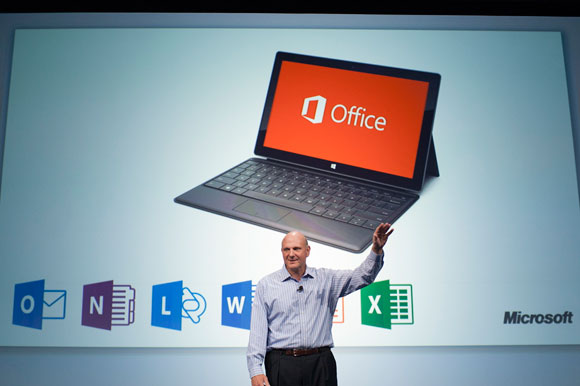
Microsoft would like everyone on the planet to adopt Office 365 and in doing so, move to subscription pricing. Customers get access to their stuff anytime, anywhere and on anything, while Microsoft sees consistent revenue stream and everyone using the newest features. But that's not happening soon. So for the majority of businesses presumably continuing with what the company describes as "on-premises versions", Office 2013 desktop and server software is now available for purchase.
Office 2013, Exchange Server 2013, Lync Server 2013, SharePoint Server 2013, Project 2013 and Visio 2013 are immediately available to volume-license subscribers. Everyone else must wait. "Broad availability of the new Office through retail and online channels is planned for the first quarter of 2013", Microsoft's Sanjay Manchanda says. The company released a trial version to MSDN and TechNet subscribers.
But you must understand that Microsoft really doesn't want anyone using Office 2013 by itself. The push remains the cloud service, which offers the productivity suite also on a subscription basis.
"The new Office is in the cloud", Manchanda says. "Coupled with new cloud services available next year, the new Office will save your documents to SkyDrive by default, and your personalized settings, templates and documents will travel with you".
Businesses purchasing by volume-licensing contract give Microsoft money in subscription-like fashion. But deploying Office 2013 on premise doesn't ensure they use the breadth of cloud services, if at all; will deploy the software everywhere at once; or keep employees on the newest versions. That said, on-premise deployment of the larger Office desktop-server stack lets adopters deploy their own private clouds, rather than rely on Microsoft.
Microsoft has five major objectives behind its new Office platform strategy:
1. Maintain the relevance of PC software. The transition from the PC to contextual cloud computing eras is unmistakable. Companies like Google shift computing and informational relevance to the cloud and drive it back to the device. Microsoft drives it the other way, leveraging off the huge Office System customer base. The strategy is sensible, but execution complicated and a process started years ago. This release cycle promises to be the one where there's seamless experience whether using software on a PC or over the Internet.
2. Extend the Office-Windows-Windows Server apps stack to the datacenter. Microsoft dominates the most successful applications stack on the planet. But in the contextual cloud computing era, it's not enough. Incumbency is a huge advantage, but not if BYOD (bring your own device) to work supplants you (There's no Office for Android or iOS, despite rumors). Microsoft bets that Surface, other Windows RT tablets, Windows 8 devices and the cloud will, along with Office System apps and servers, be the winning combination that keeps its apps stack the preferred choice, particularly among businesses.
3. Take out Google Apps. Microsoft CEO Steve Ballmer once treated the hosted suite as little more than an annoying gnat and later a yappy mutt. But Google racks up customers, by turning Apps, Gmail, Google Talk and other services into a suite that's "good enough" for much lower cost (typically ranges free to $50 per user/year); businesses are adopting Apps. Microsoft believes that Office desktop and cloud, particularly with revised subscription pricing and seamless sync, offer so much more. Again, turning incumbency back into a major asset is key.
4. Provide customers what they want most. The PC is no longer the only device most people use, and Gartner claims that within two years the cloud will replace the personal computer as primary digital content hub. Stated differently: People want access to their stuff anytime, anywhere and on anything. Microsoft seeks to do just that without disrupting its major Office system revenue stream. The hybrid apps/cloud strategy seeks to have Microsoft's cake and let customers eat it, too.
5. Make money. That seems obvious, but it's not. The Office division now generates more revenue and profit than Windows. Microsoft's challenge is how to rock the cart without spilling it over. That's why the cloud strategy is so important -- where for many customers Office 365 is primary product; they get productivity apps as part of the service, while paying ongoing subscription fees. If successful, Microsoft will further smooth revenue highs and lows. Meanwhile the company ensures customers' software is up to date, which lets it deliver more benefits faster, removes IT management burdens and makes happy subscribers willing to keep paying. By comparison, out-of-date software that IT must qualify and test leads to dissatisfaction and defection (to services like Google Apps).

